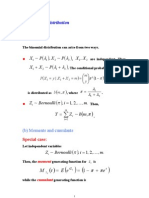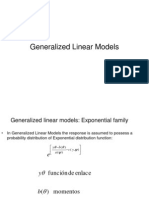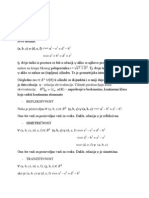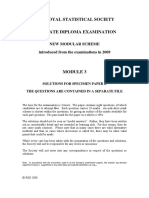(A) Modeling: 2.3 Models For Binary Responses
Uploaded by
juntujuntu(A) Modeling: 2.3 Models For Binary Responses
Uploaded by
juntujuntu1
2.3 Models for binary responses
(a) Modeling
In practice, the formal model usually embodies assumptions such as
zero correlation or independence, lack of interaction or additivity,
linearity and so on. These assumptions can not be taken for granted
and should, if possible, be checked.
For binary data, to express
as the linear combination
=
=
p
j
j j
x
1
would be inconsistent with the law of
probability. A simple and effective way of avoiding this difficulty is
to use a transformation
( ) g
that maps the unit interval
| | 1 , 0
onto the whole real line
( ) ,
. That is,
( ) = =
=
p
j
j j
x g
1
.
Several functions (link functions) commonly used in practice are:
1. The logit or logistic function
( )
|
.
|
\
|
1
log
1
g
.
2. The probit or inverse normal function
( ) ( )
1
2
= g
.
3. The complementary log-log function
( ) ( ) | | = 1 log log
3
g
.
4. The log-log function
( ) ( ) | | log log
4
= g
.
2
Note:
( ) ( ) ( ) ( ) = = 1 , 1
3 3 1 1
g g g g
.
Note:
The required inverse functions are
1. The logit or logistic function
( )
e
e
+
=
1
1 .
2. The probit or inverse normal function
( ) ( ) =
2
.
3. The complementary log-log function
( )
e
e
= 1
3
.
4. The log-log function
( )
=
e
e
4
.
Note:
The logistic function is most commonly used link function.
Note:
For the data in the motivating example, suppose the logistic link
function is used. Then,
3
( )
( )
( ) 2. , 1 , 1
exp 1
exp
1
log
2 2 1 1 0
2 2 1 1 0
2 2 1 1 0
= =
+ + +
+ +
=
+ + =
|
.
|
\
|
j
x
x x
x x
x x
j
j
The last equation implies that a larger change in
due to the
change of
j
x
as
is near 0.5 than
is near 0 or 1.
(b) Estimation
Suppose
( ) , , 2, , 1 , , ~ n i m b Y
i i i
K =
with link function
( )
=
=
|
|
.
|
\
|
= =
p
j
ij j
i
i
i i
x g
1
1
log
. Note that
( )
i i i i
m Y E = =
. The likelihood function is
( ) ( )
|
|
.
|
\
|
=
n
i
y m
i
y
i
i
i
i i
i
y
m
y f
1
1 |
and the log-likelihood function is
( ) ( ) | | ( )
( ) ( ) ( )
( )
= =
=
=
(
|
|
.
|
\
|
+
(
+
|
|
.
|
\
|
+ +
(
|
|
.
|
\
|
=
= =
n
i i
i
n
i
i i
i
i
i
n
i
i i i i i
i
i
n
i
i
y
m
m y
y m y
y
m
l y f l
1 1
1
1
log 1 log
1
log
1 log log log
| log
Thus,
4
( )
( )
( )
( )
( )
=
= =
=
=
n
i
ir i i i
n
i
ir i i
i i
i i i
n
i
r
i
i
i
i
i
r
r
x m y
x
m y l l
U
1
1 1
1
1
since
( )
( )
( )
( )
i i
i i i
i
i
i i
i
i
i
i i
i
i
i
i
i
i
i i
i
i
i
i
m y
m y
m
y
m
y
l
|
|
.
|
\
|
=
|
|
.
|
\
|
=
1
1 1
1 1
1 1
1 1 1
1 1
2
2
and
( )
( )
( )
i i
i i
i
i
i
i i
i
i
i
i
i
i
i
i
|
|
.
|
\
|
=
(
|
|
.
|
\
|
=
|
.
|
\
|
1
1
1 1
1
1 1
1 1
1
1
log
1 1
2
2
On the other hand,
( ) ( ) | |
( )
= =
= =
=
n
i
ir is i i i
n
i
ir
s
i
i
i
i
n
i
n
i
ir
s
i
i
s
ir i i i
r s
x x m x m
x m
x m y l
1 1
1 1
2
1
Therefore,
5
( )
( ) ( )
( )
=
=
=
(
=
n
i
ir is i i i
r s r s
sr
x x m
l l
E I
1
2 2
1
Denote
( )
( )
( )
( )
( )
(
(
(
(
=
(
(
(
(
=
(
(
(
(
=
(
(
(
(
(
=
n n n
n n n np n n
p
p
m
m
m
W
m
m
m
x x x
x x x
x x x
X
1 0 0
0 1 0
0 0 1
, ,
2 2 2
1 1 1
2 2
1 1
2
1
2 1
2 22 21
1 12 11
L
M O M M
L
L
M M
L
M O M M
L
L
Then, in matrix form,
( ) ( ) | | ( ) ( )X W X I y X U
t t
= = ,
The Fishers scoring method is
( ) ( ) ( )
( ) ( ) ( ) ( )
( ) ( ) ( ) ( ) ( ) | |
( ) ( )
( ) | | ( )
t t
t
t
t
t
t t
t
t t
t
t t t t
t
t t
t
t
t
t t
t
t t
t
t t t t t
z W X X W X
z W X X W X
y W X W X X W X
y X X W X X W X
t U I I
, 2 1, , 0 ,
1
1
1
1
1
1
1
+
+
+
+
+
=
=
+ =
+ =
= + = K
where
( ) ( ) ( )
t t t
tn
t
t
t
y W X
z
z
z
z
1 2
1
+ =
(
(
(
(
=
M
and
6
( )
t
i i i
i i
p
j
tj ij ti
m
y
x z
1
1
=
=
(
+ =
.
Note:
A good choice of starting value usually reduced the number of cycles
by about one or perhaps two.
Note:
After a few cycles of the weighted estimating equation, the fitted
values
| |
t
i i
m
=
are normally quite accurate but the parameter
estimates and their standard error may not be. There are two criteria
tested to detect abnormal convergence of this type. The primary
criterion is based on the change in the fitted probabilities, for
instance by using the deviance. The other is based on the change in
t
or in the linear predictor
t i
x
.
Note:
Let
( )
( )
( )
( )
2 2 2
1 1 1
1 0 0
0 1 0
0 0 1
=
(
(
(
(
= =
n n n
m
m
m
W W
L
M O M M
L
L
z
( ) ( )
1
= n O E
z
( ) ( ) ( ) | |
1
1
1
+ = n O WX X Cov
t
Note:
The above results are also true for the alternative limit in which n is
fixed and
m
.
You might also like
- RVHS JC 2 H2 Maths 2011 Mid Year Exam SolutionsNo ratings yetRVHS JC 2 H2 Maths 2011 Mid Year Exam Solutions14 pages
- Business and Administrative Communication by Kitty Locker and Donna Kienzler - 10e, TEST BANK 0073403180No ratings yetBusiness and Administrative Communication by Kitty Locker and Donna Kienzler - 10e, TEST BANK 007340318035 pages
- CS 6290: High-Performance Computer Architecture Spring 2009 Final ExamNo ratings yetCS 6290: High-Performance Computer Architecture Spring 2009 Final Exam14 pages
- (A) Model Assumptions: 1.2 Outline of Generalized Linear ModelsNo ratings yet(A) Model Assumptions: 1.2 Outline of Generalized Linear Models8 pages
- Colorado School of Mines CHEN403: F y AuNo ratings yetColorado School of Mines CHEN403: F y Au17 pages
- Y e y Y P: (A) Poisson Distribution and Poisson ProcessNo ratings yetY e y Y P: (A) Poisson Distribution and Poisson Process6 pages
- Paper 23-A New Type Method For The Structured Variational Inequalities ProblemNo ratings yetPaper 23-A New Type Method For The Structured Variational Inequalities Problem4 pages
- I. Newton-Raphson Method - 2 Dim Case: X X X X FNo ratings yetI. Newton-Raphson Method - 2 Dim Case: X X X X F9 pages
- Rss Grad Diploma Module3 Solutions Specimen B PDFNo ratings yetRss Grad Diploma Module3 Solutions Specimen B PDF10 pages
- The Yule Walker Equations For The AR Coefficients: 1 Direct InversionNo ratings yetThe Yule Walker Equations For The AR Coefficients: 1 Direct Inversion8 pages
- 3.3 The Multinomial Distribution: (A) SourceNo ratings yet3.3 The Multinomial Distribution: (A) Source6 pages
- EE644 - Discrete Time Systems Spring 2009 Midterm Exam #2 With Solutions Problem 1. Polyphase RepresentationsNo ratings yetEE644 - Discrete Time Systems Spring 2009 Midterm Exam #2 With Solutions Problem 1. Polyphase Representations5 pages
- International Journal of Mathematics and Statistics Invention (IJMSI)No ratings yetInternational Journal of Mathematics and Statistics Invention (IJMSI)7 pages
- Mech300H Introduction To Finite Element Methods: Finite Element Analysis (F.E.A.) of 1-D ProblemsNo ratings yetMech300H Introduction To Finite Element Methods: Finite Element Analysis (F.E.A.) of 1-D Problems31 pages
- MATH 437/ MATH 535: Applied Stochastic Processes/ Advanced Applied Stochastic ProcessesNo ratings yetMATH 437/ MATH 535: Applied Stochastic Processes/ Advanced Applied Stochastic Processes7 pages
- (3x) (1+ 1 3x) 1 2 3x + 1 2 (1 2 1) 2 (1 3x) + ...... ) (3x) + 1 2 (3x) 1 8 (3x) + ......No ratings yet(3x) (1+ 1 3x) 1 2 3x + 1 2 (1 2 1) 2 (1 3x) + ...... ) (3x) + 1 2 (3x) 1 8 (3x) + ......10 pages
- Collomb-Tutorial On Trigonometric Curve FittingNo ratings yetCollomb-Tutorial On Trigonometric Curve Fitting15 pages
- Interpolation Produces That Matches Exactly. The Function Then Can Be Utilized To ApproximateNo ratings yetInterpolation Produces That Matches Exactly. The Function Then Can Be Utilized To Approximate44 pages
- Power Flow Analysis: Newton-Raphson IterationNo ratings yetPower Flow Analysis: Newton-Raphson Iteration27 pages
- NYJC JC 2 H2 Maths 2011 Mid Year Exam Solutions Paper 2No ratings yetNYJC JC 2 H2 Maths 2011 Mid Year Exam Solutions Paper 27 pages
- Hw2 - Raymond Von Mizener - Chirag MahapatraNo ratings yetHw2 - Raymond Von Mizener - Chirag Mahapatra13 pages
- International Journal of Pure and Applied Mathematics No. 4 2013, 435-450No ratings yetInternational Journal of Pure and Applied Mathematics No. 4 2013, 435-45016 pages
- Quantum Mechanics - Homework Assignment 3: Alejandro G Omez Espinosa October 8, 2012No ratings yetQuantum Mechanics - Homework Assignment 3: Alejandro G Omez Espinosa October 8, 20127 pages
- Some Applications Involving Binary Data: (A) Comparison of Two Binomial ProbabilitiesNo ratings yetSome Applications Involving Binary Data: (A) Comparison of Two Binomial Probabilities7 pages
- Solutions for Exercises in Introduction to Digital Communications by Ali GramiNo ratings yetSolutions for Exercises in Introduction to Digital Communications by Ali Grami30 pages
- The Royal Statistical Society 2003 Examinations: SolutionsNo ratings yetThe Royal Statistical Society 2003 Examinations: Solutions9 pages
- Discrete Random Variables and Probability DistributionsNo ratings yetDiscrete Random Variables and Probability Distributions36 pages
- QM1 Problem Set 1 Solutions - Mike SaelimNo ratings yetQM1 Problem Set 1 Solutions - Mike Saelim5 pages
- Discrete Time Random Processes: 4.1 (A) UsingNo ratings yetDiscrete Time Random Processes: 4.1 (A) Using16 pages
- Solution Manual For Introduction To Digital Communications - Ali GramiNo ratings yetSolution Manual For Introduction To Digital Communications - Ali Grami30 pages
- Beta-Binomial - Binomial Joint Distribution of The Sample ("Likelihood"), Beta Prior100% (1)Beta-Binomial - Binomial Joint Distribution of The Sample ("Likelihood"), Beta Prior5 pages
- 1.5 Measuring The Goodness of Fit: Special CaseNo ratings yet1.5 Measuring The Goodness of Fit: Special Case6 pages
- Estabilidad Interna y Entrada-Salida de Sistemas Continuos: Udec - DieNo ratings yetEstabilidad Interna y Entrada-Salida de Sistemas Continuos: Udec - Die10 pages
- A New Non-Symmetric Information Divergence ofNo ratings yetA New Non-Symmetric Information Divergence of7 pages
- An Introduction To Variational Calculus in Machine LearningNo ratings yetAn Introduction To Variational Calculus in Machine Learning7 pages
- Mean Value of A Smarandache-Type FunctionNo ratings yetMean Value of A Smarandache-Type Function4 pages
- An Introduction To Scalar Kalman Filters PDFNo ratings yetAn Introduction To Scalar Kalman Filters PDF10 pages
- 3 Transformations in Regression: Y X Y XNo ratings yet3 Transformations in Regression: Y X Y X13 pages
- 5 One-Way ANOVA (Review) and Experimental DesignNo ratings yet5 One-Way ANOVA (Review) and Experimental Design15 pages
- 9 Review of Discrete Data Analysis: Comparing Two Proportions: Independent SamplesNo ratings yet9 Review of Discrete Data Analysis: Comparing Two Proportions: Independent Samples18 pages
- Unit2 - Love, A Chemical Reaction (Textbook)No ratings yetUnit2 - Love, A Chemical Reaction (Textbook)8 pages
- 12 Physics Notes Ch01 Electric Charges and FieldNo ratings yet12 Physics Notes Ch01 Electric Charges and Field3 pages
- Grammatical Signals Pattern of Development PartNo ratings yetGrammatical Signals Pattern of Development Part4 pages
- 4.5 - Datex Ohmeda Aestiva 5 Brochure and Specs PDFNo ratings yet4.5 - Datex Ohmeda Aestiva 5 Brochure and Specs PDF1 page
- ISIS Multi Stage Thermostat Start/Stop 7 Day Programmable BrochureNo ratings yetISIS Multi Stage Thermostat Start/Stop 7 Day Programmable Brochure2 pages
- Phutikettrkit,+3 +RFID+Hospitals+-+Edited+by+HBDSNo ratings yetPhutikettrkit,+3 +RFID+Hospitals+-+Edited+by+HBDS10 pages
- Business and Administrative Communication by Kitty Locker and Donna Kienzler - 10e, TEST BANK 0073403180Business and Administrative Communication by Kitty Locker and Donna Kienzler - 10e, TEST BANK 0073403180
- CS 6290: High-Performance Computer Architecture Spring 2009 Final ExamCS 6290: High-Performance Computer Architecture Spring 2009 Final Exam
- (A) Model Assumptions: 1.2 Outline of Generalized Linear Models(A) Model Assumptions: 1.2 Outline of Generalized Linear Models
- Y e y Y P: (A) Poisson Distribution and Poisson ProcessY e y Y P: (A) Poisson Distribution and Poisson Process
- Paper 23-A New Type Method For The Structured Variational Inequalities ProblemPaper 23-A New Type Method For The Structured Variational Inequalities Problem
- The Yule Walker Equations For The AR Coefficients: 1 Direct InversionThe Yule Walker Equations For The AR Coefficients: 1 Direct Inversion
- EE644 - Discrete Time Systems Spring 2009 Midterm Exam #2 With Solutions Problem 1. Polyphase RepresentationsEE644 - Discrete Time Systems Spring 2009 Midterm Exam #2 With Solutions Problem 1. Polyphase Representations
- International Journal of Mathematics and Statistics Invention (IJMSI)International Journal of Mathematics and Statistics Invention (IJMSI)
- Mech300H Introduction To Finite Element Methods: Finite Element Analysis (F.E.A.) of 1-D ProblemsMech300H Introduction To Finite Element Methods: Finite Element Analysis (F.E.A.) of 1-D Problems
- MATH 437/ MATH 535: Applied Stochastic Processes/ Advanced Applied Stochastic ProcessesMATH 437/ MATH 535: Applied Stochastic Processes/ Advanced Applied Stochastic Processes
- (3x) (1+ 1 3x) 1 2 3x + 1 2 (1 2 1) 2 (1 3x) + ...... ) (3x) + 1 2 (3x) 1 8 (3x) + ......(3x) (1+ 1 3x) 1 2 3x + 1 2 (1 2 1) 2 (1 3x) + ...... ) (3x) + 1 2 (3x) 1 8 (3x) + ......
- Interpolation Produces That Matches Exactly. The Function Then Can Be Utilized To ApproximateInterpolation Produces That Matches Exactly. The Function Then Can Be Utilized To Approximate
- NYJC JC 2 H2 Maths 2011 Mid Year Exam Solutions Paper 2NYJC JC 2 H2 Maths 2011 Mid Year Exam Solutions Paper 2
- International Journal of Pure and Applied Mathematics No. 4 2013, 435-450International Journal of Pure and Applied Mathematics No. 4 2013, 435-450
- Quantum Mechanics - Homework Assignment 3: Alejandro G Omez Espinosa October 8, 2012Quantum Mechanics - Homework Assignment 3: Alejandro G Omez Espinosa October 8, 2012
- Some Applications Involving Binary Data: (A) Comparison of Two Binomial ProbabilitiesSome Applications Involving Binary Data: (A) Comparison of Two Binomial Probabilities
- Solutions for Exercises in Introduction to Digital Communications by Ali GramiSolutions for Exercises in Introduction to Digital Communications by Ali Grami
- The Royal Statistical Society 2003 Examinations: SolutionsThe Royal Statistical Society 2003 Examinations: Solutions
- Discrete Random Variables and Probability DistributionsDiscrete Random Variables and Probability Distributions
- Solution Manual For Introduction To Digital Communications - Ali GramiSolution Manual For Introduction To Digital Communications - Ali Grami
- Beta-Binomial - Binomial Joint Distribution of The Sample ("Likelihood"), Beta PriorBeta-Binomial - Binomial Joint Distribution of The Sample ("Likelihood"), Beta Prior
- Estabilidad Interna y Entrada-Salida de Sistemas Continuos: Udec - DieEstabilidad Interna y Entrada-Salida de Sistemas Continuos: Udec - Die
- An Introduction To Variational Calculus in Machine LearningAn Introduction To Variational Calculus in Machine Learning
- A-level Maths Revision: Cheeky Revision ShortcutsFrom EverandA-level Maths Revision: Cheeky Revision Shortcuts
- 9 Review of Discrete Data Analysis: Comparing Two Proportions: Independent Samples9 Review of Discrete Data Analysis: Comparing Two Proportions: Independent Samples
- 4.5 - Datex Ohmeda Aestiva 5 Brochure and Specs PDF4.5 - Datex Ohmeda Aestiva 5 Brochure and Specs PDF
- ISIS Multi Stage Thermostat Start/Stop 7 Day Programmable BrochureISIS Multi Stage Thermostat Start/Stop 7 Day Programmable Brochure







































































































